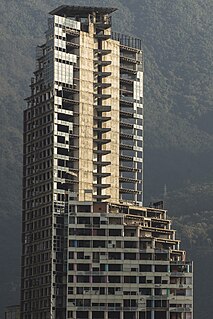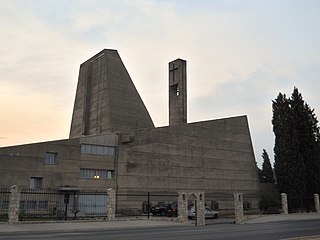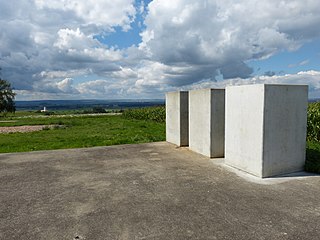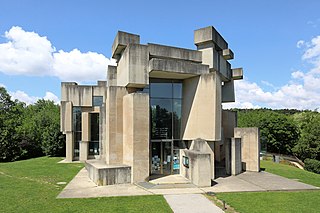 W
WBrutalist architecture, or New Brutalism, is an architectural style which emerged during the 1950s in Great Britain, among the reconstruction projects of the post-war era. Brutalist buildings are characterised by minimalist constructions that showcase the bare building materials and structural elements over decorative design. The style commonly makes use of exposed concrete or brick, angular geometric shapes and a predominantly monochrome colour palette; other materials, such as steel, timber, and glass, are also featured.
 W
WBrutalism is an architectural style that spawned from the modernist architectural movement and which flourished from the 1950s to the 1970s. The following list provides numerous examples of this architectural style worldwide.
 W
WBéton brut is a French term that translates in English to “raw concrete”. The term is used to describe concrete that is left unfinished after being cast, displaying the patterns and seams imprinted on it by the formwork. Béton brut is not a material itself, but rather an architectural expression of concrete.
 W
WThe Al Zaqura Building is an Iraqi government building situated in the Green Zone in the capital Baghdad. Maintained by the office of the Prime Minister of Iraq, it is occupied by the office of the prime minister. It is also known as Al Zaqura Palace.
 W
WThe architecture of Casablanca is diverse and historically significant. Casablanca, Morocco's economic capital, has a rich urban history and is home to many notable buildings in a variety of styles. Throughout the 20th century, architecture and urban development in Casablanca evolved in a way that was simultaneously specific to the city's contexts, and consonant with international ideas.
 W
WThe Maurice Ravel Auditorium is a concert hall located in Part-Dieu, the 3rd district of Lyon. It was originally built for the National Orchestra of Lyon and is their residence hall. It is also one of the first buildings in France to be built with Prestressed concrete.
 W
WThe Bank of Georgia headquarters is a building in Tbilisi, Georgia. It was designed by architects George Chakhava and Zurab Jalaghania for the Ministry of Highway Construction of the Georgian SSR and finished in 1975. The engineer was Temur Tkhilava. This 18-story building was acquired by the Bank of Georgia in 2007.
 W
WThe CBR Building is an office building situated in Watermaal-Bosvoorde in Brussels, designed by architects Constantin Brodzki and Marcel Lambrichs.
 W
WCentro Financiero Confinanzas, also known as Torre de David, is an unfinished abandoned skyscraper in Caracas, the capital of Venezuela. It is the third highest skyscraper in the country after the twin towers of Parque Central Complex. The construction of the tower began in 1990 but was halted in 1994 due to the Venezuelan banking crisis. As of 2018, the building remains incomplete and unused. It was damaged due to two earthquakes on 21 and 22 August 2018.
 W
WThe Church of the Holy Heart of Jesus is the only Roman Catholic church in the city of Podgorica, Montenegro. It was built in 1969, replacing the city centre church which was destroyed during the bombing of Podgorica in World War II. The church is a unique example of brutalist architecture, and is located in Konik neighborhood.
 W
WThe Elion-Hitchings Building on Cornwallis Road in Research Triangle Park, North Carolina, U.S. is an architecturally significant Brutalist building designed by Paul Rudolph and completed in 1972 as the headquarters for Burroughs Wellcome. Part of the original building and a later addition have been torn down. In 2020, the owners plan to tear down the remainder of the building, but many oppose this action.
 W
WThe Embassy of the United States of America in Havana is the United States of America's diplomatic mission in Cuba. On January 3, 1961, US President Dwight D. Eisenhower severed relations following the Cuban Revolution of the 1950s. In 1977, President Jimmy Carter and President Fidel Castro signed an Interests Sections Agreement that permitted each government to operate out of its former embassy in Havana and Washington D.C., which were called Interests Sections; they were prohibited from flying their respective flags. Cuban President Raúl Castro and US President Barack Obama restored full diplomatic connections on July 20, 2015.
 W
WThe Friedenskirche is a protestant church in Monheim-Baumberg, Schellingstraße 13, built from 1968 to 1974 according to the plans of Walter Maria Foerderer in the style of Brutalism.
 W
WHøjen 13 is a villa and listed building in Aarhus, Denmark. The villa was built in 1958 and was listed in the Danish registry of protected buildings and places by the Danish Heritage Agency on 11 January 2008. The house was built by the architect Knud Friis as his home and study on a hill overlooking Brabrand Lake in the Brabrand suburb.
 W
WThe House of Soviets is an unfinished building located in the city of Kaliningrad in the Kaliningrad Oblast, an exclave of Russia. The local people often refer to it as the "buried robot" because its appearance resembles the head of a giant robot which is buried in the ground up to the shoulders. The chief architect was Lev Misoshnikov. It was built on the original site of Königsberg Castle.
 W
WKyrgyz National Philharmonic is a landmark building in Bishkek, Kyrgyzstan and home to musical performances. It was designed by A. Pechonkin and completed in 1980. The building faces city hall. It is named after Toktogul Satylganov. A statue of Manas and fountains are on the grounds. The building's architecture is brutalist from the Soviet era.
 W
WMamutica is the largest building in Zagreb and Croatia, as well as one of the largest apartment blocks in Europe.
 W
WMaria, Königin des Friedens is a pilgrimage church and parish in Neviges, part of Velbert, North Rhine-Westphalia, Germany. The pilgrimage dates back to 1676. Neviges was the home of a Franciscan monastery from 1675 until the end of 2019. A church dedicated to the Immaculate Conception in 1728 became too small for the growing numbers of pilgrims in the 20th century.
 W
WThe Sibelius Museum is a museum of music, named after the Finnish composer Jean Sibelius. The museum is located close to Turku Cathedral in the historical city centre of Turku on the southwest coast of Finland. It is the only museum devoted to music in Finland. The museum houses a wide collection of historical music instruments from around the world. The archives of the museum include documents The museum was first founded during the 1920s as a seminar for the Department of Musicology at Åbo Akademi University, and has later developed into its own department. The Museum is currently organised and funded by the Åbo Akademi Foundation. The current building was built and opened in 1968 and it was designed by architect Woldemar Baeckman.
 W
WThe Teresa Carreño Cultural Complex, also known as Teresa Carreño Theater, is the most important theatre of Caracas and Venezuela, where performances include symphonic and popular concerts, opera, ballet and plays. It is the second largest theater in South America after the Néstor Kirchner Cultural Centre at Buenos Aires.
 W
WThe Time Pyramid is a work of public art by Manfred Laber under construction in Wemding, Germany. The pyramid, begun in 1993, at the 1,200th anniversary of Wemding, will take another 1162 years to complete and is scheduled to be finished in the year 3183. As of 2021, the first 3 of its scheduled 120 concrete blocks have been placed.
 W
WThe Unité d'habitation is a modernist residential housing design principle developed by Le Corbusier, with the collaboration of painter-architect Nadir Afonso. The concept formed the basis of several housing developments designed by him throughout Europe with this name. The most famous of these developments is located in south Marseille.
 W
WWestern City Gate, also known as the Genex Tower, is a 36-story skyscraper in Belgrade, Serbia, which was designed in 1977 by Mihajlo Mitrović in the brutalist style. It is formed by two towers connected with a two-story bridge and revolving restaurant at the top. It is 117 m (384 ft) tall and is the second-tallest high-rise in Belgrade after Ušće Tower.
 W
WThe Kirche Zur Heiligsten Dreifaltigkeit in Vienna, better known as the Wotruba Church, is located on the Sankt Georgenberg in Mauer in Liesing, the 23rd District of Vienna. It was built between August 1974 and October 1976 on the basis of a model by Fritz Wotruba.